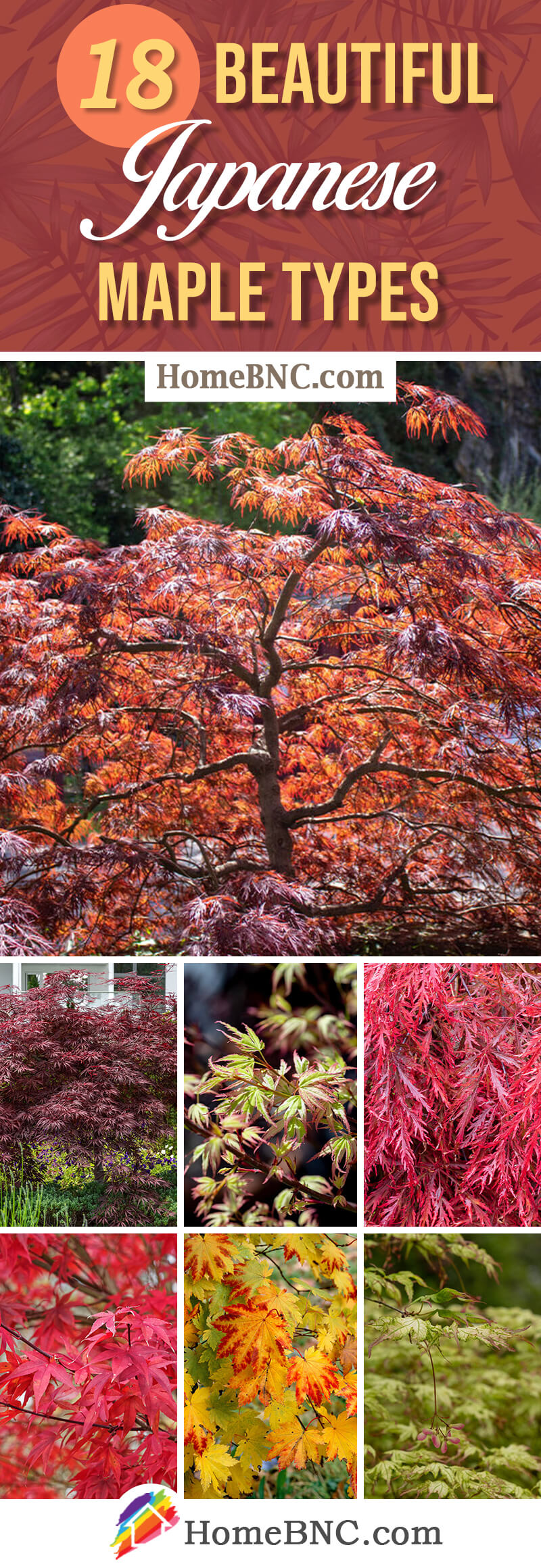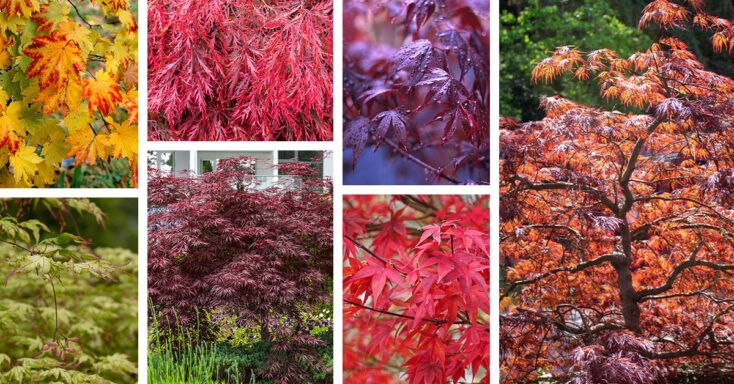If you are at all familiar with typical residential landscape planting designs, then you already know that the Japanese maple is one of the most popular tree options in existence. However, what you likely did not know is how many types of Japanese maples there are for you to choose from. As our list in this article will show, the plant group known as Japanese maples includes multiple species and more cultivated varieties than you would ever imagine. Read on through each entry to learn which type of Japanese maple tree is right for you and your garden.
Key Takeaways
Since nearly all Japanese maple trees are relatively closely related to one another, the group as a whole often features some similar characteristics. As such, there are a few main themes that you will likely pick up on while you read through our list of the best Japanese maple tree varieties. Below is a quick summary of the five key takeaways from the article that you are about to read.
- Japanese maples consist of a few main species, including Acer palmatum, Acer japonicum, and Acer shirasawanum.
- From the main naturally occurring species, many Japanese maple cultivars have come into being.
- Most Japanese maples have interesting foliage color during the entire growing season.
- Most Japanese maples are small trees.
- Japanese maple trees rarely, if ever, feature flowers that have ornamental appeal.
18 Inspiring Types of Japanese Maples that Are Perfect for Any Garden
1. Japanese Maple (Acer palmatum)
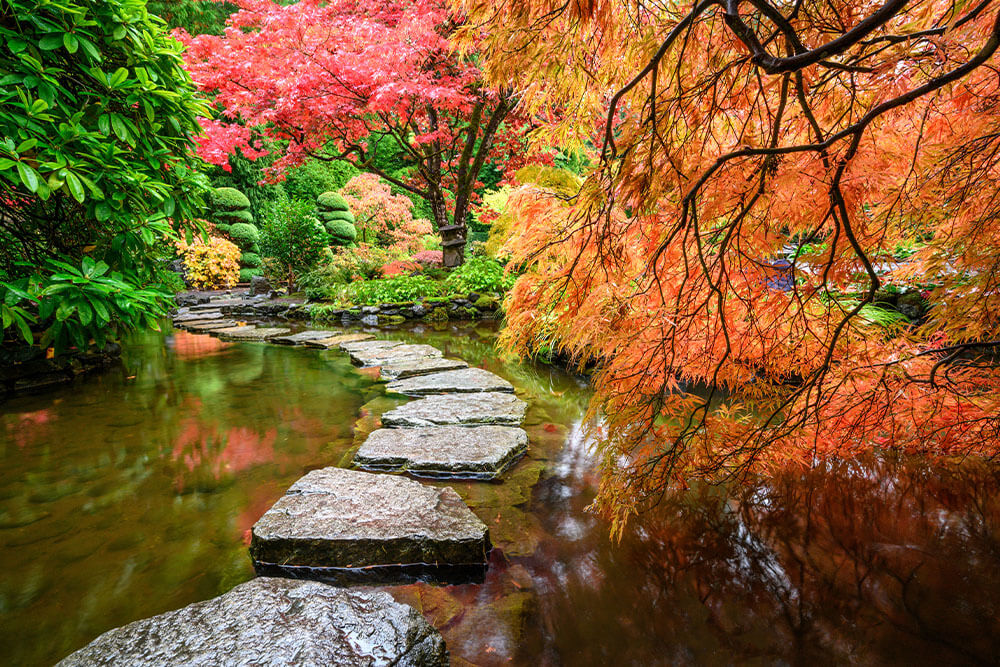
The best way to start off this list of the best Japanese maple tree varieties is by presenting what is likely the species that is most commonly referred to as Japanese maple, Acer palmatum. This naturally occurring Japanese maple comes from East Asia, has a leaf color and shape that is typical of a Japanese maple, and is the parent species of many of the other Japanese maple cultivars in existence and on this list. Acer palmatum is as attractive as any of the cultivars it has parented, which is why this species continues to be a popular planting choice despite the many other Japanese maple options you’ll soon learn about.
2. Aconitifolium Japanese Maple (Acer japonicum ‘Aconitifolium’)
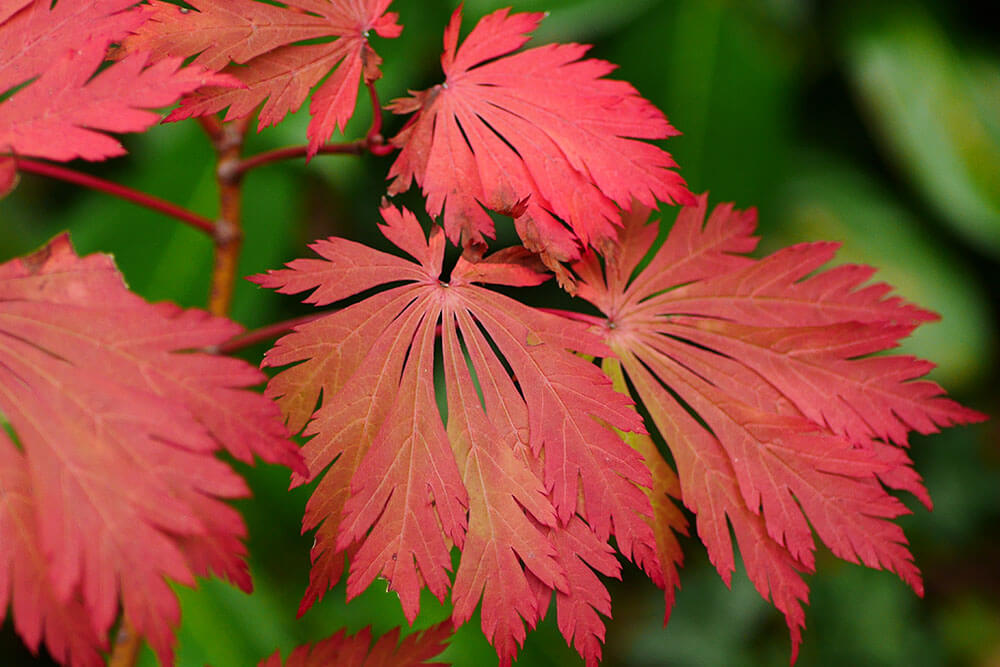
The Aconitifolium Japanese maple is a Japanese maple tree variety that can go by several different names, including Fernleaf Japanese maple, Full Moon Japanese maple, and its scientific name, Acer japonicum ‘Aconitifolium’. The fact that this plant has multiple names, some of which match the common names of other Japanese maple cultivars, can cause some confusion. However, once you learn to recognize the Aconitifolium Japanese maple, you’ll begin to know it well. This small tree is a dwarf variety with a rounded shrub-like form and a set of uniquely shaped leaves.
3. Beni Kawa Japanese Maple (Acer palmatum ‘Beni-kawa’)
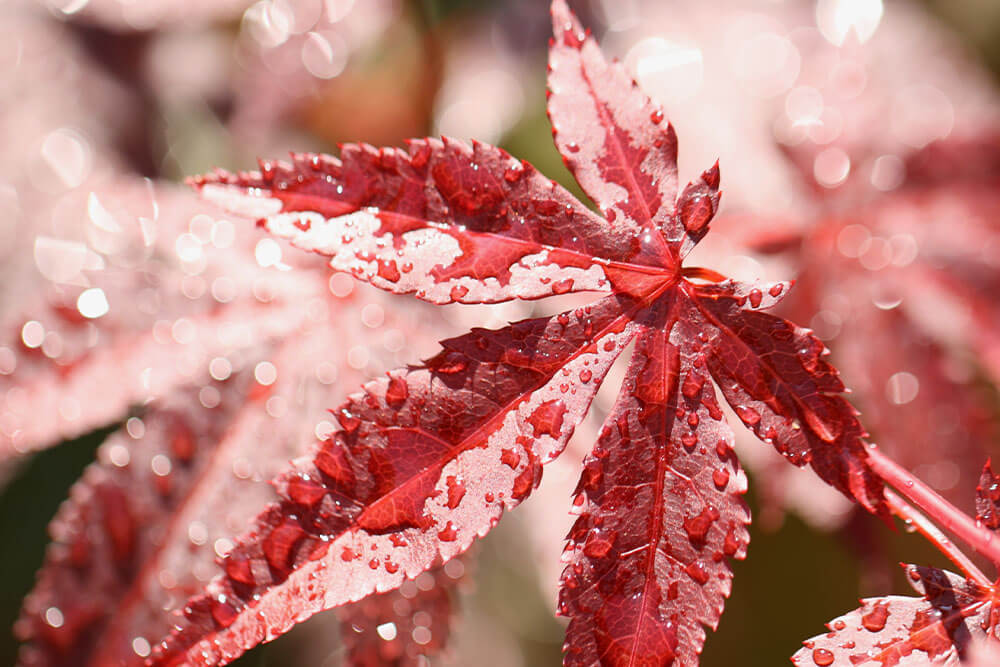
Most people expect that all Japanese maple trees have red foliage during all parts of the year. After all, the red leaves of these trees are one of the main reasons why these plants are so popular in the first place. However, it is not always the case that a Japanese maple tree will have consistently red leaves, as this entry proves. The Beni Kawa Japanese maple tree has foliage that begins with a typical leafy green hue. As the growing season elapses, the leaves will steadily become lighter, taking on more golden hues. By the fall, the leaves will be entirely golden before they fall to the ground.
4. Bloodgood Japanese Maple (Acer palmatum atropurpureum ‘Bloodgood’)

Here we have reached one of the most popular cultivated Japanese maple varieties in the world, and it is no surprise that this tree has earned that distinction after learning about its ornamental features. The bloodgood Japanese maple tree is a small tree that reaches about 20 feet tall with a graceful multi-stemmed habit. Throughout nearly all parts of the spring, summer, and fall, the foliage of the bloodgood Japanese maple tree will remain a bold dark red, which is where the plant gets its common name. The bloodgood Japanese maple tree is also adaptable to hardiness zones 5 through 9 and proves to be relatively easy to care for overall.
5. Butterfly Japanese Maple (Acer palmatum ‘Butterfly’)

You would expect the Butterfly Japanese maple tree to have a fun and fluttery appearance in one way or another. Fittingly, that whimsical appearance is precisely what this tree will provide. Again, the butterfly Japanese maple tree is another example of a Japanese maple that deviates from the typical red foliage hues. However, that does not mean that the leaves of the butterfly Japanese maple are not attractive. On the contrary, the leaves of this plant are its main appeal. Each leaf can vary in color from light green to a creamy silvery hue. Each one also has small, pointed lobes that sometimes curl upward and add great texture to the canopy.
6.Coral Bark Japanese Maple (Acer palmatum ‘Sango-kaku’)
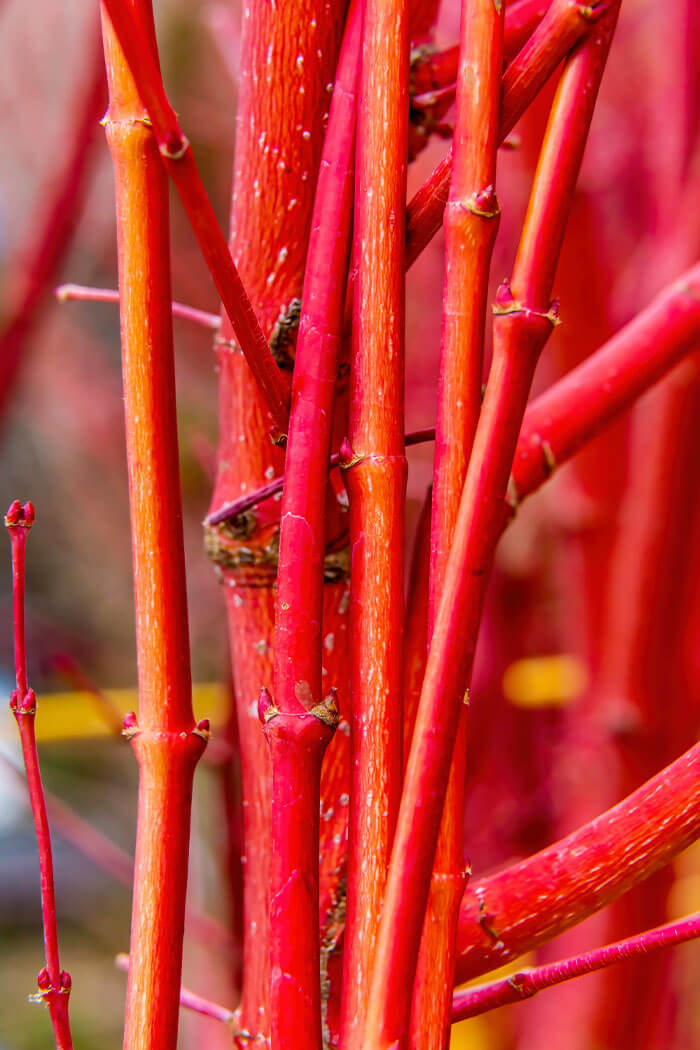
There are plenty of reasons to love a Japanese maple tree. Most often, people find beauty in the leaves and overall form of these plants. However, that does not mean that the bark of a Japanese maple tree is destined to be ordinary. Instead, the coral bark Japanese maple tree is an example of a variety that has spectacular stems and branches, each of which holds a vibrant red hue that allows this plant to add visual interest even in the most desolate winter months. With that said, the leaves of the Coral bark Japanese maple are lovely too, as they feature shades of both light green with red accents.
7. Crimson Queen Japanese Maple (Acer palmatum dissectum ‘Crimson Queen’)

The crimson queen Japanese maple is another cultivated variety that proves to be a bit more popular than the rest. As was true regarding the bloodgood Japanese maple, that disproportionate popularity may be entirely justified. The crimson queen cultivar is a dwarf variety, which means that it will fit well even in garden areas that have limited growing space. At most, the crimson queen Japanese maple will reach 10 feet tall, but even that is rare. This plant also has an eye-catching weeping growth habit and a set of leaves that have a lace-like texture and shape, which makes it incredibly visually stimulating despite being small.
8. Emperor 1 Japanese Maple (Acer palmatum ‘Wolff’)
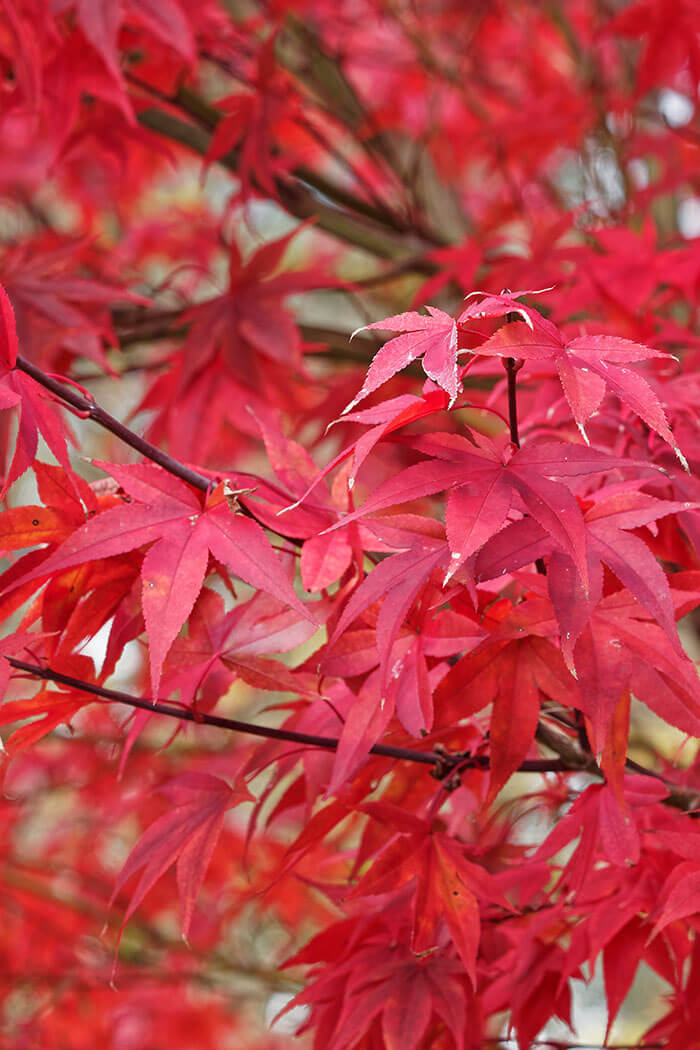
The emperor 1 Japanese maple tree is another moderately-sized variety that fits well in many growing locations. This tree is also further proof that even subtle differences in the foliage of a Japanese maple can allow it to stand out from other planting options. In this case, the leaves of the emperor 1 Japanese maple tree are bright red from the moment they emerge in the spring. They also feature some lovely contrasts since the bottom sides of the leaves have a contrasting light green shade. Overall, the emperor 1 Japanese maple has an upright vase shape, which means it is lovely to look at from both near and far.
9. Filigree Japanese Maple (Acer palmatum dissectum ‘Filigree’)

The filigree Japanese maple tree is a cultivar that gets its appeal from both its weeping habit and its beautiful foliage. This tree grows to be about five feet tall at maturity, and the growth habit of this plant allows its spread to be about the same size. Each leaflet on the filigree Japanese maple tree has a complex shape that makes for a fine texture. The leaves are also light green throughout the spring and summer, which deviates from what other Japanese maples typically present. Then, in the fall, those light green leaves will turn to a light golden orange color just before the winter cold begins to arrive.
10. First Ghost Japanese Maple (Acer palmatum ‘First Ghost’)
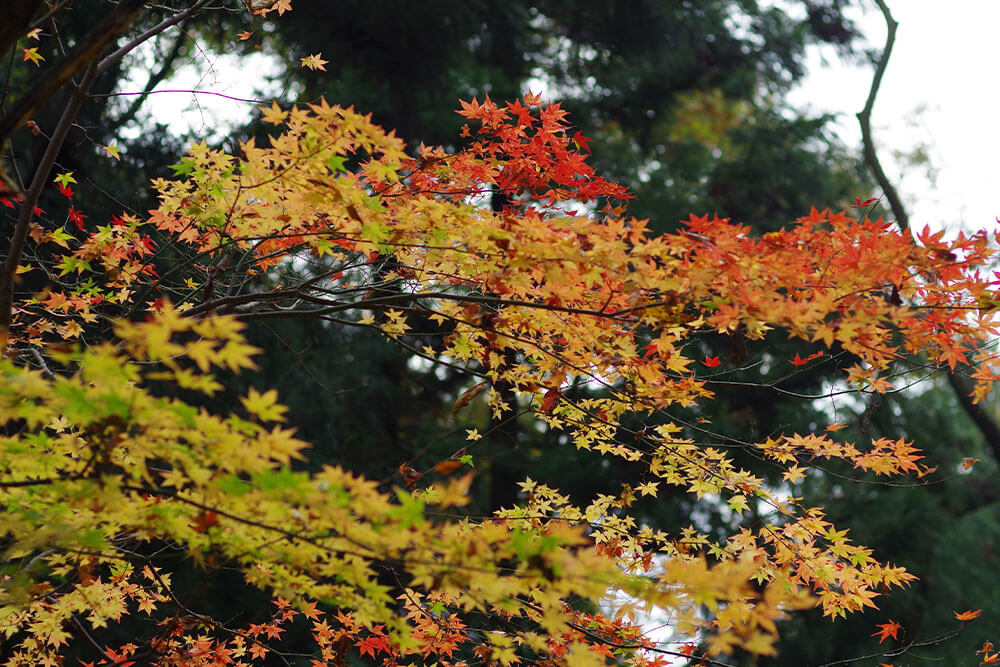
By now, we have celebrated the beauty of the foliage of many Japanese maple varieties to the point where you would not likely believe us if we told you that this list entry may have the most spectacular foliage of all. The first ghost Japanese maple tree has leaves with long, somewhat wavy lobes that almost look like fingers. Each leaf can vary in color, but many of them are primarily a light-yellow color, with wine-colored tinges at the margin. The veins of each leaf tend to have a dark green shade which only adds to the contrasting color display that each leaf provides.
11. Garnet Japanese Maple (Acer palmatum dissectum ‘Garnet’)
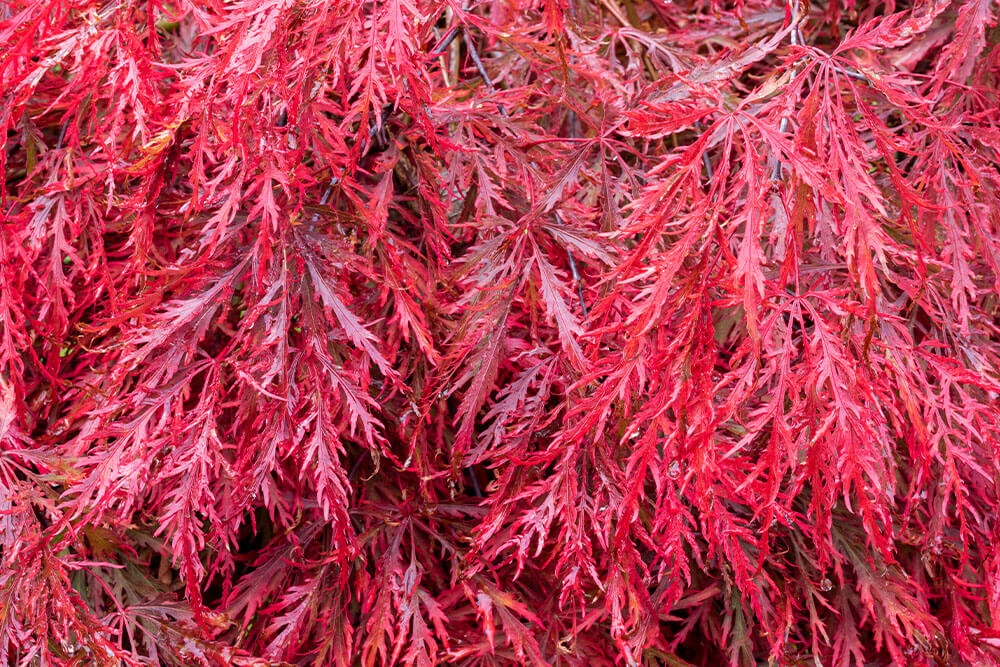
Vibrance and a uniquely blended growth habit are what make the garnet Japanese maple a must-have plant option for some Japanese maple tree enthusiasts. This small tree somehow seems to combine an upright stem and branching habit with a canopy that seems to weep in a slightly pendulous manner. The garnet Japanese maple tree also has vibrant foliage that is very thin and lacy, even compared to other varieties that have lace-like leaves. That combination of growth habit and leaf color allows the garnet Japanese maple to be a focal point no matter where you plant it.
12. Golden Full Moon Japanese Maple (Acer shirasawanum ‘Aureum’)

This Japanese maple tree option stands out among the other options on this list due to the fact that it does not come from the species Acer palmatum or Acer japonicum. Instead, the golden full moon Japanese maple tree is a cultivar of the Acer shirasawanum species. The leaves of this cultivar are far more rounded than those of other Japanese maples, which may help you identify this species. The leaves also do not have the deep dramatic lobes and sinuses that other Japanese maple leaves have. For most of the year, those leaves are light green, but in the fall, they will gradually become a striking golden orange.
13. Green Cascade Japanese Maple (Acer japonicum ‘Green Cascade’)

The previous entry on our list had some of the simplest leaves of any Japanese maple tree you can find. By contrast, the leaves of the green cascade Japanese maple tree are some of the most complex ones you’ll see. Each leaf holds many feathery lobes, each of which is quite thin with an irregular, sometimes jagged, margin. As is the case with other Japanese maples that are green during the growing season, the green cascade Japanese maple has a fantastic fall color, which in this case is a striking deep red.
14. Laceleaf Japanese Maple (Acer palmatum dissectum)
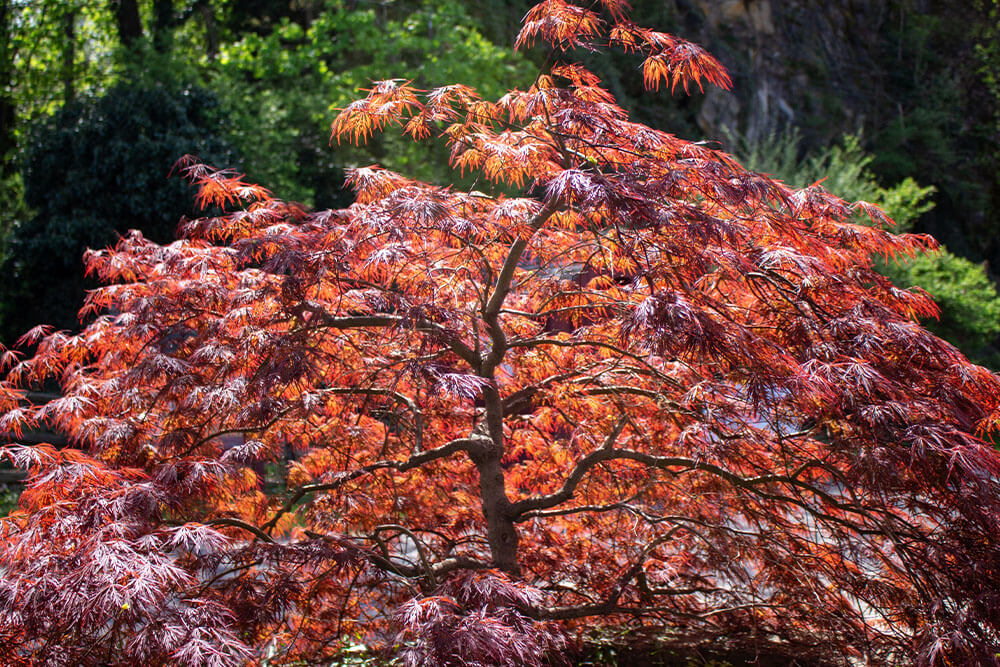
At the beginning of this list, we mentioned the primary Japanese maple variety as Acer palmatum. That species has given rise to many cultivars and maple subgroups, including this entry, Acer palmatum dissectum, which itself has served as the parent variety for many subsequent cultivars. This variety, known commonly as laceleaf Japanese maple, among other names, is a dwarf species with deeply cut leaves that make a lace-like shape. In most cases, the laceleaf Japanese maple tree will grow with a multi-stemmed habit and will remain quite small due to the fact that it is a dwarf variety.
15. Peaches and Cream Japanese Maple (Acer palmatum ‘Peaches and Cream’)
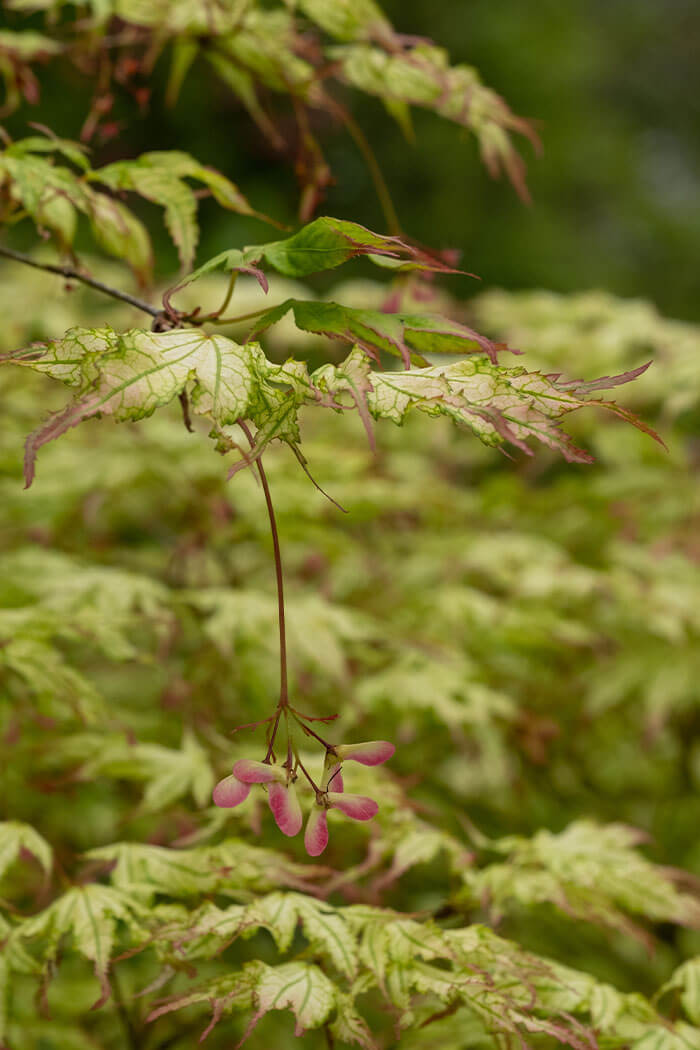
The peaches and cream Japanese maple tree is one of the rarer Japanese maple varieties, which is why it may not be as easy to find as some of the other options we have presented on this list. Still, that does not mean that this distinct option is not worth seeking out. As the name suggests, the peaches and cream Japanese maple tree has light peach-colored leaves. In addition to those light leaves, this tree also has a lovely growth habit that consists of several main stems that spread outward in dramatic fashion to create a wide canopy.
16. Red Dragon Japanese Maple (Acer palmatum dissectum ‘Red Dragon’)

There are a few Japanese maple tree varieties on this list that have featured leaves that change color throughout the growing season. Interestingly, most of those color-changing options go from lighter colors to darker colors as the season progresses. However, the red dragon Japanese maple tree breaks from that trend. Its leaves emerge with a dark red color that is almost purple. Then, at the end of the growing season, the dark purple swiftly switches to a light and vibrant red. Those leaves are also lace-like and hang on branches that have a weeping habit.
17. Tamukeyama Dwarf Japanese Maple (Acer palmatum dissectum ‘Tamukeyama’)
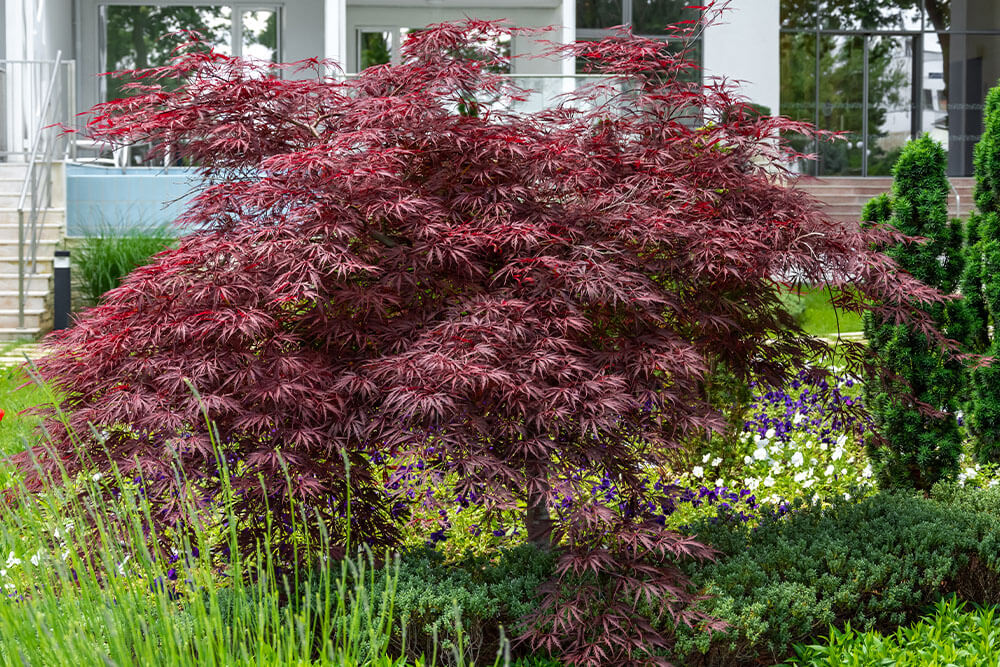
While there are many Japanese maple trees that have distinct features, the Tamukeyama dwarf Japanese maple somehow manages to combine most, if not all, of the Japanese maple traits that people far and wide have come to know and love. For example, the leaves of this plant are lace-like, reddish-purple, and incredibly vibrant. The canopy of the Tamukeyama dwarf Japanese maple is also appealing since it is wide and weeping. This Japanese maple tree option also proves to be very convenient to grow since it reaches a moderate size and does not call for any difficult maintenance.
18. Vitifolium Japanese Maple (Acer japonicum ‘Vitifolium’)
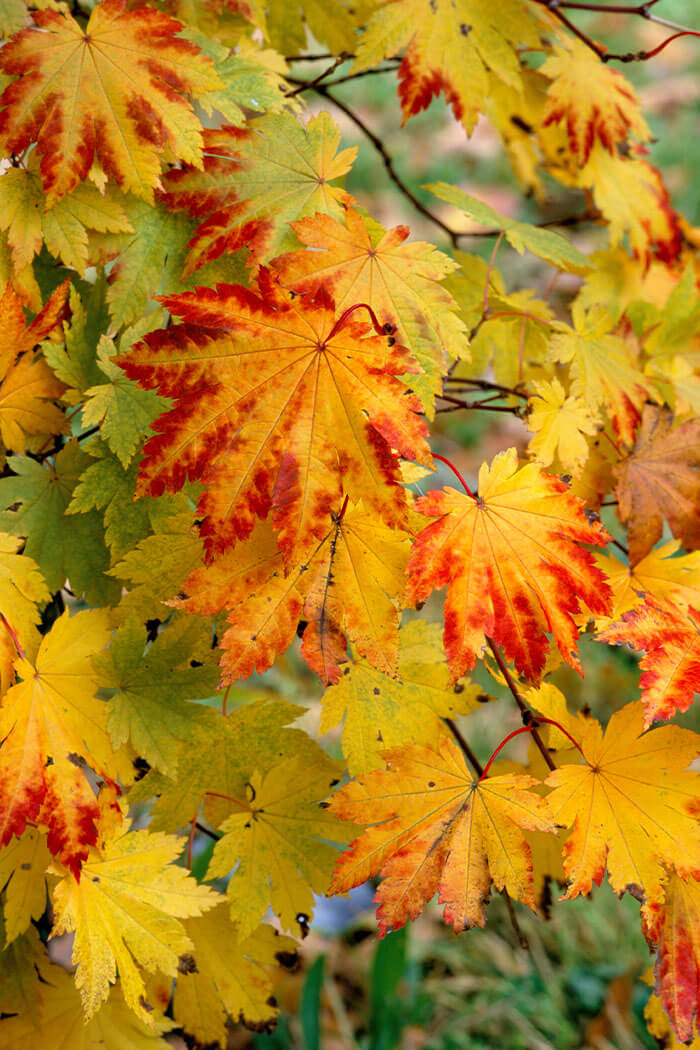
At times, it can be difficult to tell whether it is more accurate to call the final entry on our list a small tree or a large shrub. The Vitifolium Japanese maple grows to be a little over ten feet tall and tends to have a rounded shape. This plant also has a set of leaves that are surprisingly rounded compared to most other Japanese maples and have a lovely shade during all parts of the year when they are present. However, if you want those leaves to look their best, you should be careful about planting the Vitifolium Japanese maple in full-sun areas, especially in the hotter parts of the growing range, as that can lead to leaf discoloration.
Since there are so many different types of Japanese maple trees, there is also a relatively large amount of information that is related to these beautiful plants. In fact, reading through our list of the best Japanese maples is not enough to make you an expert on the topic, but studying more about these trees eventually will. To help you along that path, we’ve provided a few brief answers to the questions that gardeners ask most commonly about Japanese maple trees.
Frequently Asked Questions About Japanese Maples
Are There Different Types of Japanese Maples?
There are many different types of Japanese maple trees, some of which are far more common than others. For example, the three main Japanese maple tree species include Acer palmatum, Acer japonicum, and Acer shirasawanum, with Acer palmatum being the most widespread. Additionally, since these species are so naturally elegant, people have taken the time to create many cultivated varieties of Japanese maples. These cultivars feature different sizes, growth habits, colors, and more. As such, it is important to understand that there are different types of Japanese maples before you settle on one for your yard.
What is the Most Beautiful Japanese Maple Variety?
As is true regarding any plant group, the designation of the most beautiful variety within the Japanese maple family is entirely a matter of opinion. For instance, if you value a tree with more texture, you’ll likely prefer one of the cultivars of the Laceleaf Japanese Maple. Likewise, if you prefer a smaller tree, then you’ll most likely consider one of the dwarf varieties of Japanese maple to be the most beautiful. Further, those who love the prolonged red leaves of a Japanese maple will want to select a variety that emphasizes that trait. In short, the most beautiful Japanese maple is a matter of choice, and there are plenty of options to choose from.
What is the Most Popular Japanese Maple Tree?
There are many popular types of Japanese maple trees. In fact, even the parent species, Acer palmatum, of many cultivars, is popular in its natural form. Other specific cultivars, such as the Bloodgood Japanese maple, are particularly popular. In the case of the Bloodgood Japanese maple tree, the main value comes from the leaves, which vary from dark purple to light green depending on the season. In addition, varieties such as the Emperor I Japanese maple and the Crimson Queen Japanese maple are also incredibly popular.
Which Japanese Maple is Always Red?
One of the main features that make a Japanese maple tree stand out is the fact that the foliage of this plant remains red for most of the growing season. The reason for this is that Japanese maple leaves have different amounts of pigment than the leaves of greener plants. Mainly, Japanese maples have lower ratios of chlorophyll, which is the pigment responsible for keeping most plant leaves within some shade of green.
Why is My Japanese Maple Green and Not Red?
In some cases, the reason why your Japanese maple tree is not remaining red and turns green instead may be an underlying disease or complication that your tree is experiencing. However, it is more likely the case that you simply own a Japanese maple tree variety that has a variable leaf color. For instance, many Japanese maple trees will be a lighter, more green color during the hottest and sunniest parts of the year. As such, you should take time to see if this is the case for your tree before you assume there is something wrong with it.
18 Elegant Types of Japanese Maples that Have Lovely Leaves
There is more to the world of Japanese maple trees than you probably assumed when you first started reading this article. As it turns out, there is a plentiful amount of Japanese maple tree species and cultivars for you to choose from. And, as you now know, each of the most popular Japanese maple tree varieties is often quite similar to the others while also having a few unique traits that help set it apart. After you find which of those unique traits is most appealing to you, you will have found the Japanese maple tree that is best for you.
